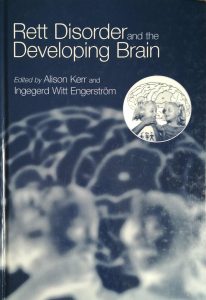FOREWORD (v)
PREFACE (ix)
LIST OF CONTRIBUTORS (xvii)
1 The clinical background to the Rett disorder. Alison M. Kerr and Ingegerd Witt Engerstrom (1)
ROOTS OF DISORDER
2 Towards the genetic basis of Rett syndrome. Angus Clarke, Carolyn Schanen and Maria Anvret (27)
3 The neuropathology of the Rett disorder. Dawna D. Armstrong and Hannah C. Kinney (57)
4 Cortical development in Rett syndrome: molecular, neurochemical, and anatomical aspects. Walter E. Kaufmann (85)
5.1 The Rett syndrome: proposed mechanisms of genetic origin and inheritance. Maj A. Hulten (111)
5.2 Amino acid receptor studies in Rett syndrome. Mary E. Blue and Michael V. Johnston (117)
5.3 Melatonin and Rett syndrome disorder. Sarojini S. Budden (121)
5.4 Early abnormality in pterin levels in Rett syndrome. Souad Messahel, Anne E. Pheasant, Hardiv Pall and Alison M. Kerr (125)
5.5 Neurotrophic factors in the pathogenesis of Rett syndrome. Raili Riikonen (127)
NEURONS IN ACTION
6 The central autonomic disturbance in Rett syndrome. Peter O. O. Julu (131)
7 The role of genetic and environmental factors in brain development: development of the central monoaminergic nervous system. Masaya Segawa (183)
8 The monoamine hypothesis in Rett syndrome. Yoshiko Nomura nd Masaya Segawa (205)
9 The central and peripheral autonomic nervous system and possible implications in Rett syndrome patients. Annica Dahlstrom (227)
10.1 Autonomic dysfunction and sudden death in Rett syndrome: prolonged QTc intervals and diminished heart rate variability. Daniel G. Glaze and Rebecca J. Schultz (251)
10.2 Feeding in Rett syndrome. Richard Morton (257)
10.3 Oropharyngeal dysfunction and upper gastrointestinal dysmotility, a reflection of disturbances in the autonomic nervous system in Rett syndrome. Kathleen J. Motil, Rebeca J. Schultz, Daniel G. Glaze and Dawna Armstrong (259)
10.4 Possible link between skeletal and electrocardiographic abnormalities and autonomic dysfunction in Rett syndrome. Helen Leonard, Susan Fyfe and Carolyn Ellaway (265)
10.5 The electroencephalogram in Rett syndrome. Rosemary A. Cooper (269)
10.6 Electromagnetic stimulation of motor neurons. Urban M. Fietzek, F. Heinen, U. Ziemann, H. Petersen, K. Huhn, J. Schulte-Monting, H. J. Christen, R. Korinthenberg and F. Hanefeld (275)
EXPRESSING INTELLIGENCE
11 The morphological substrate for communication. Pavel V. Belichenko (277)
12 Early infant intelligence and Rett syndrome. Colwyn Trevarthen and Bronwen Burford (303)
13 Musical responsiveness in the Rett disorder. Bjorn Merker and Nils L. Wallin (327)
14.1 Behavioural and emotional features of Rett syndrome. Rebecca Mount, Richard Hastings, Tony Charman, Sheena Reilly and Hilary Cass (339)
14.2 Vision in Rett syndrome: studies using evoked potentials and event-related potentials. Daphne L. McCulloch, Ross M. Henderson, Kathryn J. Saunders, and R. M. Walley (343)
CONCLUDING CHAPTER
15 The developmental perspective in Rett disorder: where next? Alison M. Kerr and Ingegerd Witt Engerstrom (349)
ABBREVIATIONS AND GLOSSARY (361)
INDEX (367)

